+ Open data
Open data
- Basic information
Basic information
| Entry | Database: PDB / ID: 5flx | ||||||
|---|---|---|---|---|---|---|---|
| Title | Mammalian 40S HCV-IRES complex | ||||||
 Components Components |
| ||||||
 Keywords Keywords |  RIBOSOME / RIBOSOME /  TRANSLATION INITIATION / TRANSLATION INITIATION /  HEPATITIS C VIRUS INTERNAL RIBOSOME ENTRY SITE HEPATITIS C VIRUS INTERNAL RIBOSOME ENTRY SITE | ||||||
| Function / homology |  Function and homology information Function and homology informationpositive regulation of cysteine-type endopeptidase activity involved in execution phase of apoptosis / negative regulation of endoplasmic reticulum unfolded protein response / oxidized pyrimidine DNA binding / response to TNF agonist / positive regulation of base-excision repair / protein tyrosine kinase inhibitor activity / positive regulation of intrinsic apoptotic signaling pathway in response to DNA damage / positive regulation of respiratory burst involved in inflammatory response / positive regulation of gastrulation / IRE1-RACK1-PP2A complex ...positive regulation of cysteine-type endopeptidase activity involved in execution phase of apoptosis / negative regulation of endoplasmic reticulum unfolded protein response / oxidized pyrimidine DNA binding / response to TNF agonist / positive regulation of base-excision repair / protein tyrosine kinase inhibitor activity / positive regulation of intrinsic apoptotic signaling pathway in response to DNA damage / positive regulation of respiratory burst involved in inflammatory response / positive regulation of gastrulation / IRE1-RACK1-PP2A complex / nucleolus organization / : / positive regulation of endodeoxyribonuclease activity / positive regulation of Golgi to plasma membrane protein transport / TNFR1-mediated ceramide production / negative regulation of RNA splicing / negative regulation of DNA repair / laminin receptor activity / oxidized purine DNA binding / negative regulation of intrinsic apoptotic signaling pathway in response to hydrogen peroxide /  supercoiled DNA binding / neural crest cell differentiation / rRNA modification in the nucleus and cytosol / negative regulation of phagocytosis / supercoiled DNA binding / neural crest cell differentiation / rRNA modification in the nucleus and cytosol / negative regulation of phagocytosis /  NF-kappaB complex / ubiquitin-like protein conjugating enzyme binding / regulation of establishment of cell polarity / positive regulation of ubiquitin-protein transferase activity / Formation of the ternary complex, and subsequently, the 43S complex / erythrocyte homeostasis / cytoplasmic side of rough endoplasmic reticulum membrane / positive regulation of signal transduction by p53 class mediator / ubiquitin ligase inhibitor activity / NF-kappaB complex / ubiquitin-like protein conjugating enzyme binding / regulation of establishment of cell polarity / positive regulation of ubiquitin-protein transferase activity / Formation of the ternary complex, and subsequently, the 43S complex / erythrocyte homeostasis / cytoplasmic side of rough endoplasmic reticulum membrane / positive regulation of signal transduction by p53 class mediator / ubiquitin ligase inhibitor activity /  pigmentation / pigmentation /  protein kinase A binding / negative regulation of ubiquitin protein ligase activity / Ribosomal scanning and start codon recognition / ion channel inhibitor activity / Translation initiation complex formation / phagocytic cup / positive regulation of mitochondrial depolarization / negative regulation of Wnt signaling pathway / positive regulation of T cell receptor signaling pathway / positive regulation of activated T cell proliferation / protein kinase A binding / negative regulation of ubiquitin protein ligase activity / Ribosomal scanning and start codon recognition / ion channel inhibitor activity / Translation initiation complex formation / phagocytic cup / positive regulation of mitochondrial depolarization / negative regulation of Wnt signaling pathway / positive regulation of T cell receptor signaling pathway / positive regulation of activated T cell proliferation /  fibroblast growth factor binding / fibroblast growth factor binding /  regulation of cell division / SARS-CoV-1 modulates host translation machinery / regulation of cell division / SARS-CoV-1 modulates host translation machinery /  Protein hydroxylation / Protein hydroxylation /  iron-sulfur cluster binding / iron-sulfur cluster binding /  TOR signaling / TOR signaling /  BH3 domain binding / mTORC1-mediated signalling / endonucleolytic cleavage to generate mature 3'-end of SSU-rRNA from (SSU-rRNA, 5.8S rRNA, LSU-rRNA) / positive regulation of intrinsic apoptotic signaling pathway by p53 class mediator / Peptide chain elongation / Selenocysteine synthesis / monocyte chemotaxis / cysteine-type endopeptidase activator activity involved in apoptotic process / Formation of a pool of free 40S subunits / BH3 domain binding / mTORC1-mediated signalling / endonucleolytic cleavage to generate mature 3'-end of SSU-rRNA from (SSU-rRNA, 5.8S rRNA, LSU-rRNA) / positive regulation of intrinsic apoptotic signaling pathway by p53 class mediator / Peptide chain elongation / Selenocysteine synthesis / monocyte chemotaxis / cysteine-type endopeptidase activator activity involved in apoptotic process / Formation of a pool of free 40S subunits /  ribosomal small subunit export from nucleus / positive regulation of cyclic-nucleotide phosphodiesterase activity / Eukaryotic Translation Termination / Response of EIF2AK4 (GCN2) to amino acid deficiency / translation regulator activity / SRP-dependent cotranslational protein targeting to membrane / Viral mRNA Translation / Nonsense Mediated Decay (NMD) independent of the Exon Junction Complex (EJC) / GTP hydrolysis and joining of the 60S ribosomal subunit / negative regulation of respiratory burst involved in inflammatory response / negative regulation of phosphatidylinositol 3-kinase/protein kinase B signal transduction / L13a-mediated translational silencing of Ceruloplasmin expression / Major pathway of rRNA processing in the nucleolus and cytosol / ribosomal small subunit export from nucleus / positive regulation of cyclic-nucleotide phosphodiesterase activity / Eukaryotic Translation Termination / Response of EIF2AK4 (GCN2) to amino acid deficiency / translation regulator activity / SRP-dependent cotranslational protein targeting to membrane / Viral mRNA Translation / Nonsense Mediated Decay (NMD) independent of the Exon Junction Complex (EJC) / GTP hydrolysis and joining of the 60S ribosomal subunit / negative regulation of respiratory burst involved in inflammatory response / negative regulation of phosphatidylinositol 3-kinase/protein kinase B signal transduction / L13a-mediated translational silencing of Ceruloplasmin expression / Major pathway of rRNA processing in the nucleolus and cytosol /  gastrulation / endonucleolytic cleavage in ITS1 to separate SSU-rRNA from 5.8S rRNA and LSU-rRNA from tricistronic rRNA transcript (SSU-rRNA, 5.8S rRNA, LSU-rRNA) / gastrulation / endonucleolytic cleavage in ITS1 to separate SSU-rRNA from 5.8S rRNA and LSU-rRNA from tricistronic rRNA transcript (SSU-rRNA, 5.8S rRNA, LSU-rRNA) /  rough endoplasmic reticulum / spindle assembly / regulation of translational fidelity / MDM2/MDM4 family protein binding / rough endoplasmic reticulum / spindle assembly / regulation of translational fidelity / MDM2/MDM4 family protein binding /  laminin binding / laminin binding /  Protein methylation / Nonsense Mediated Decay (NMD) enhanced by the Exon Junction Complex (EJC) / Amplification of signal from unattached kinetochores via a MAD2 inhibitory signal / Nuclear events stimulated by ALK signaling in cancer / negative regulation of smoothened signaling pathway / rescue of stalled ribosome / signaling adaptor activity / positive regulation of cell cycle / negative regulation of peptidyl-serine phosphorylation / Protein methylation / Nonsense Mediated Decay (NMD) enhanced by the Exon Junction Complex (EJC) / Amplification of signal from unattached kinetochores via a MAD2 inhibitory signal / Nuclear events stimulated by ALK signaling in cancer / negative regulation of smoothened signaling pathway / rescue of stalled ribosome / signaling adaptor activity / positive regulation of cell cycle / negative regulation of peptidyl-serine phosphorylation /  translation initiation factor binding / translation initiation factor binding /  stress granule assembly / maturation of SSU-rRNA / positive regulation of intrinsic apoptotic signaling pathway / Mitotic Prometaphase / maturation of SSU-rRNA from tricistronic rRNA transcript (SSU-rRNA, 5.8S rRNA, LSU-rRNA) / class I DNA-(apurinic or apyrimidinic site) endonuclease activity / EML4 and NUDC in mitotic spindle formation / positive regulation of apoptotic signaling pathway / Maturation of protein E / negative regulation of ubiquitin-dependent protein catabolic process / positive regulation of microtubule polymerization stress granule assembly / maturation of SSU-rRNA / positive regulation of intrinsic apoptotic signaling pathway / Mitotic Prometaphase / maturation of SSU-rRNA from tricistronic rRNA transcript (SSU-rRNA, 5.8S rRNA, LSU-rRNA) / class I DNA-(apurinic or apyrimidinic site) endonuclease activity / EML4 and NUDC in mitotic spindle formation / positive regulation of apoptotic signaling pathway / Maturation of protein E / negative regulation of ubiquitin-dependent protein catabolic process / positive regulation of microtubule polymerizationSimilarity search - Function | ||||||
| Biological species |  HEPATITIS C VIRUS HEPATITIS C VIRUS  ORYCTOLAGUS CUNICULUS (rabbit) ORYCTOLAGUS CUNICULUS (rabbit) | ||||||
| Method |  ELECTRON MICROSCOPY / ELECTRON MICROSCOPY /  single particle reconstruction / single particle reconstruction /  cryo EM / Resolution: 3.9 Å cryo EM / Resolution: 3.9 Å | ||||||
 Authors Authors | Yamamoto, H. / Collier, M. / Loerke, J. / Ismer, J. / Schmidt, A. / Hilal, T. / Sprink, T. / Yamamoto, K. / Mielke, T. / Burger, J. ...Yamamoto, H. / Collier, M. / Loerke, J. / Ismer, J. / Schmidt, A. / Hilal, T. / Sprink, T. / Yamamoto, K. / Mielke, T. / Burger, J. / Shaikh, T.R. / Dabrowski, M. / Hildebrand, P.W. / Scheerer, P. / Spahn, C.M.T. | ||||||
 Citation Citation |  Journal: EMBO J / Year: 2015 Journal: EMBO J / Year: 2015Title: Molecular architecture of the ribosome-bound Hepatitis C Virus internal ribosomal entry site RNA. Authors: Hiroshi Yamamoto / Marianne Collier / Justus Loerke / Jochen Ismer / Andrea Schmidt / Tarek Hilal / Thiemo Sprink / Kaori Yamamoto / Thorsten Mielke / Jörg Bürger / Tanvir R Shaikh / ...Authors: Hiroshi Yamamoto / Marianne Collier / Justus Loerke / Jochen Ismer / Andrea Schmidt / Tarek Hilal / Thiemo Sprink / Kaori Yamamoto / Thorsten Mielke / Jörg Bürger / Tanvir R Shaikh / Marylena Dabrowski / Peter W Hildebrand / Patrick Scheerer / Christian M T Spahn /   Abstract: Internal ribosomal entry sites (IRESs) are structured cis-acting RNAs that drive an alternative, cap-independent translation initiation pathway. They are used by many viruses to hijack the ...Internal ribosomal entry sites (IRESs) are structured cis-acting RNAs that drive an alternative, cap-independent translation initiation pathway. They are used by many viruses to hijack the translational machinery of the host cell. IRESs facilitate translation initiation by recruiting and actively manipulating the eukaryotic ribosome using only a subset of canonical initiation factor and IRES transacting factors. Here we present cryo-EM reconstructions of the ribosome 80S- and 40S-bound Hepatitis C Virus (HCV) IRES. The presence of four subpopulations for the 80S•HCV IRES complex reveals dynamic conformational modes of the complex. At a global resolution of 3.9 Å for the most stable complex, a derived atomic model reveals a complex fold of the IRES RNA and molecular details of its interaction with the ribosome. The comparison of obtained structures explains how a modular architecture facilitates mRNA loading and tRNA binding to the P-site. This information provides the structural foundation for understanding the mechanism of HCV IRES RNA-driven translation initiation. | ||||||
| History |
| ||||||
| Remark 700 | SHEET DETERMINATION METHOD: DSSP THE SHEETS PRESENTED AS "LA" IN EACH CHAIN ON SHEET RECORDS BELOW ... SHEET DETERMINATION METHOD: DSSP THE SHEETS PRESENTED AS "LA" IN EACH CHAIN ON SHEET RECORDS BELOW IS ACTUALLY AN 5-STRANDED BARREL THIS IS REPRESENTED BY A 6-STRANDED SHEET IN WHICH THE FIRST AND LAST STRANDS ARE IDENTICAL. THE SHEETS PRESENTED AS "XA" IN EACH CHAIN ON SHEET RECORDS BELOW IS ACTUALLY AN 5-STRANDED BARREL THIS IS REPRESENTED BY A 6-STRANDED SHEET IN WHICH THE FIRST AND LAST STRANDS ARE IDENTICAL. |
- Structure visualization
Structure visualization
| Movie |
 Movie viewer Movie viewer |
|---|---|
| Structure viewer | Molecule:  Molmil Molmil Jmol/JSmol Jmol/JSmol |
- Downloads & links
Downloads & links
- Download
Download
| PDBx/mmCIF format |  5flx.cif.gz 5flx.cif.gz | 1.7 MB | Display |  PDBx/mmCIF format PDBx/mmCIF format |
|---|---|---|---|---|
| PDB format |  pdb5flx.ent.gz pdb5flx.ent.gz | 1.4 MB | Display |  PDB format PDB format |
| PDBx/mmJSON format |  5flx.json.gz 5flx.json.gz | Tree view |  PDBx/mmJSON format PDBx/mmJSON format | |
| Others |  Other downloads Other downloads |
-Validation report
| Arichive directory |  https://data.pdbj.org/pub/pdb/validation_reports/fl/5flx https://data.pdbj.org/pub/pdb/validation_reports/fl/5flx ftp://data.pdbj.org/pub/pdb/validation_reports/fl/5flx ftp://data.pdbj.org/pub/pdb/validation_reports/fl/5flx | HTTPS FTP |
|---|
-Related structure data
| Related structure data |  3221MC  3223C  3224C  3225C  3226C M: map data used to model this data C: citing same article ( |
|---|---|
| Similar structure data |
- Links
Links
- Assembly
Assembly
| Deposited unit | 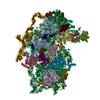
|
|---|---|
| 1 |
|
- Components
Components
-RNA chain , 2 types, 2 molecules 1z
| #1: RNA chain |  18S ribosomal RNA 18S ribosomal RNAMass: 602776.875 Da / Num. of mol.: 1 / Source method: isolated from a natural source / Source: (natural)   ORYCTOLAGUS CUNICULUS (rabbit) / References: ORYCTOLAGUS CUNICULUS (rabbit) / References:  GenBank: 36162 GenBank: 36162 |
|---|---|
| #35: RNA chain | Mass: 162190.062 Da / Num. of mol.: 1 Source method: isolated from a genetically manipulated source Source: (gene. exp.)  HEPATITIS C VIRUS / Production host: HEPATITIS C VIRUS / Production host:   ORYCTOLAGUS CUNICULUS (rabbit) ORYCTOLAGUS CUNICULUS (rabbit) |
+40S RIBOSOMAL PROTEIN ... , 31 types, 31 molecules ABCDEFGHIJKLMNOPQRSTUVWXYZabcde
-Protein , 2 types, 2 molecules fg
| #33: Protein | Mass: 18004.041 Da / Num. of mol.: 1 / Source method: isolated from a natural source / Source: (natural)   ORYCTOLAGUS CUNICULUS (rabbit) / References: UniProt: P62979 ORYCTOLAGUS CUNICULUS (rabbit) / References: UniProt: P62979 |
|---|---|
| #34: Protein | Mass: 35115.652 Da / Num. of mol.: 1 / Source method: isolated from a natural source / Source: (natural)   ORYCTOLAGUS CUNICULUS (rabbit) / References: UniProt: P63244 ORYCTOLAGUS CUNICULUS (rabbit) / References: UniProt: P63244 |
-Non-polymers , 2 types, 76 molecules 


| #36: Chemical | ChemComp-MG / #37: Chemical | |
|---|
-Experimental details
-Experiment
| Experiment | Method:  ELECTRON MICROSCOPY ELECTRON MICROSCOPY |
|---|---|
| EM experiment | Aggregation state: PARTICLE / 3D reconstruction method:  single particle reconstruction single particle reconstruction |
- Sample preparation
Sample preparation
| Component | Name: MAMMALIAN 80S HCV-IRES COMPLEX, CLASSICAL / Type: RIBOSOME |
|---|---|
| Buffer solution | Name: 20MM TRIS-HCL, 7.5MM MGCL2, 100MM KCL, 0.2MM SPERMIDINE, 2MM DTT pH: 7.6 Details: 20MM TRIS-HCL, 7.5MM MGCL2, 100MM KCL, 0.2MM SPERMIDINE, 2MM DTT |
| Specimen | Embedding applied: NO / Shadowing applied: NO / Staining applied : NO / Vitrification applied : NO / Vitrification applied : YES : YES |
| Specimen support | Details: HOLEY CARBON |
Vitrification | Instrument: FEI VITROBOT MARK I / Cryogen name: ETHANE Details: VITRIFICATION 1 -- CRYOGEN- ETHANE, HUMIDITY- 100, TEMPERATURE- 93, INSTRUMENT- FEI VITROBOT MARK I, METHOD- BLOT FOR 2-4 SECONDS BEFORE PLUNGING, |
- Electron microscopy imaging
Electron microscopy imaging
| Experimental equipment |  Model: Titan Krios / Image courtesy: FEI Company |
|---|---|
| Microscopy | Model: FEI TITAN KRIOS / Date: Oct 16, 2014 |
| Electron gun | Electron source : :  FIELD EMISSION GUN / Accelerating voltage: 300 kV / Illumination mode: FLOOD BEAM FIELD EMISSION GUN / Accelerating voltage: 300 kV / Illumination mode: FLOOD BEAM |
| Electron lens | Mode: BRIGHT FIELD Bright-field microscopy / Nominal magnification: 75000 X / Calibrated magnification: 130293 X / Nominal defocus max: 4500 nm / Nominal defocus min: 2000 nm / Cs Bright-field microscopy / Nominal magnification: 75000 X / Calibrated magnification: 130293 X / Nominal defocus max: 4500 nm / Nominal defocus min: 2000 nm / Cs : 2.7 mm : 2.7 mm |
| Image recording | Electron dose: 20 e/Å2 / Film or detector model: FEI FALCON II (4k x 4k) |
- Processing
Processing
| EM software |
| ||||||||||||
|---|---|---|---|---|---|---|---|---|---|---|---|---|---|
CTF correction | Details: CTFFIND3 | ||||||||||||
| Symmetry | Point symmetry : C1 (asymmetric) : C1 (asymmetric) | ||||||||||||
3D reconstruction | Resolution: 3.9 Å / Num. of particles: 171820 / Nominal pixel size: 1.07 Å / Actual pixel size: 1.07 Å Details: SUBMISSION BASED ON EXPERIMENTAL DATA FROM EMDB EMD-3221. (DEPOSITION ID: 13955). Symmetry type: POINT | ||||||||||||
| Atomic model building | Space: REAL | ||||||||||||
| Refinement | Highest resolution: 3.9 Å | ||||||||||||
| Refinement step | Cycle: LAST / Highest resolution: 3.9 Å
|
 Movie
Movie Controller
Controller



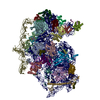
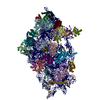
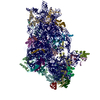

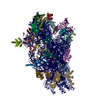
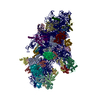

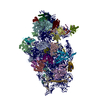

 PDBj
PDBj





















































